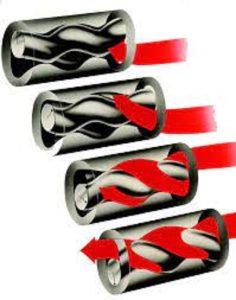What is a mono pump?
Mono pumps are a type of centrifugal pump with a single rotor, can operate horizontally or vertically, and are used in a number of applications. The term “mono” means that this pump contains only one rotor or stator.
Monopumps have a special design. They contain a rotor and a stator. The rotor has a rotating shaft inside and a rotor face placed on it. The stator is fixed around the rotor and has a stator surface compatible with the surface of the rotor.
Mono pumps are also called worm pumps, screw pumps or screw pumps. Monopumps can be used easily in the transfer of difficult fluids, and monopumps are preferred in the transfer of many fluids that are viscous, abrasive, sticky, contain solid particles and dust.
Working principle of monopumps
The working principle of monopumps is based on the compression and expansion movements caused by the rotation of the rotor and creates a continuous cyclic flow. As the rotor rotates, the compression and expansion movements are constantly repeated, thus ensuring continuous pumping of the liquid. This principle allows mono pumps to transfer liquid effectively and efficiently. As the rotor rotates, the compression action on the rotor surface pushes against the stator surface and the compressed fluid is forced forward. This process allows the liquid to pass through the mono pump and keeps the flow going. Monopump is based on the principle of transferring the fluid to a metal screw that moves with the logic of a worm screw, with the power it receives from the electric motor.
Working principle steps of mono pumps:
The working principle of mono pumps is based on the compression and expansion movement between the rotor and stator.
 Initially, there is a gap between the rotor and stator. When the pump starts, the rotor begins to rotate.
Initially, there is a gap between the rotor and stator. When the pump starts, the rotor begins to rotate.- The rotational motion on the surface of the rotor begins to push the fluid towards the center of the rotor. This causes compression of the fluid and a pressure increase between the outer surface of the rotor and the stator surface.
- With the increase in pressure, the compressed liquid moves forward on the outer surface of the stator. Since the inner surface of the stator is compatible with the surface of the rotor, it fits tightly to the inner surface of the stator with the rotating movement of the rotor pushing the liquid.
- As the liquid moves across the inner surface of the stator with the rotational motion of the rotor, it passes from the compression zone to the expansion zone. In this expansion region, the pressure energy of the liquid turns into velocity energy.
- Finally, the liquid accelerates as it moves towards the pump outlet and is transferred to the pipeline or application in the system.
Advantages of mono pumps
Monopumps have many advantages. These include high efficiency, low energy consumption, low maintenance requirement, quiet operation, high pressure capacity and the ability to operate in a wide liquid viscosity range.
The main advantages of mono pumps:
- High Efficiency: Mono pumps have a rotor-stator design that can operate efficiently. This ensures high efficiency and helps save energy.
- Wide Viscosity Range: Mono pumps can operate in a wide viscosity range, from low viscosity liquids to high viscosity liquids. This makes them suitable for different liquids in various industries.p
- Self-Priming: Monopumps can absorb liquid thanks to their self-priming capabilities. This means that the pump does not need an additional suction pump to suck up liquid from the environment in which it is placed.
- Low NPSH Requirement: NPSH (Net Positive Suction Pressure) is low for mono pumps. This means the pump has a low suction pressure requirement. Thus, the pump is not affected by pressure losses in the suction line and operates more efficiently.
- Low Maintenance: Monopumps have a simple design and contain few moving parts. This means low maintenance. Additionally, thanks to its single rotor and stator structure, the need for spare parts is low.
- High Pressure Capacity: Monopumps can pump liquid over long distances and high places with their high pressure capacity. This feature is useful in applications that require liquid transfer over long distances.
- Quiet Operation: Mono pumps operate with low noise levels. This feature makes it preferred in sound-sensitive environments.
Therefore, Monopumps are reliable and effective pump solutions widely used in many industries such as chemical, food and beverage, water treatment, oil and gas, pharmaceutical, mining.
Use of Mono Pumps in industrial applications
In many industrial applications, when rotor and stator materials are selected appropriately, monopumps can be easily used in different processes and fluid transfers. In addition, it can be used appropriately in different processes by changing the frequency, flow rate and transfer speed of the fluid by using additional equipment.
 Stainless Steel Products
Stainless Steel Products Mixing
Mixing Pumps
Pumps Heat Exchangers
Heat Exchangers System Solutions
System Solutions